AWS Certification Training
- 180k Enrolled Learners
- Weekend/Weekday
- Live Class
In today’s fast-paced and data-driven world, industrial tech companies strive to stay ahead by seeking innovative solutions. Imagine a bustling manufacturing plant with thousands of machines generating enormous amounts of data every second. This data is crucial for optimizing production efficiency, detecting anomalies, and ensuring smooth operations. However, traditional batch processing methods often fall short of providing timely insights. They analyze data at fixed intervals, causing delays that lead to missed opportunities, decreased productivity, and increased costs. But fear not! Enter Azure Stream Analytics, a game-changer for industrial tech companies. This powerful tool seamlessly integrates with IoT devices, sensors, and other data sources, enabling companies to process, analyze, and take action on streaming data in real time. Let’s delve into how and why Azure Stream Analytics has become an indispensable tool for industrial tech companies.
Azure Stream Analytics is a powerful and versatile service offered by Microsoft Azure, providing real-time data processing and analytics capabilities. With its seamless integration with various Azure services, it has become a preferred choice for both industrial projects and streaming OTT platforms. In this blog, we will explore the features, benefits, and applications of Stream Analytics, with a focus on its implementation in industrial settings and its integration with other services for streaming OTT platforms.
Table of Contents:

Azure Stream Analytics is a server less service, which means you don’t need to worry about managing any infrastructure. You simply create a job, specify the input data sources, and write a query to process the data. It will then automatically scale the processing resources to match the volume of data. It supports a wide variety of input data sources, including Azure Event Hubs, Azure IoT Hub, Azure Blob Storage, and others. It also supports a variety of output data sinks, including Azure Data Lake Storage, Azure SQL Database, and others.
It offers many key features and benefits, including: 
Building an Azure Stream Analytics Environment
To get started with Azure Stream Analytics, you will need to:
Once you have created an Azure subscription, you must create an Azure Stream Analytics job. To do this, you will need to:
Once you have created an Azure Stream Analytics job, you must configure input and output sources. Input sources are where your streaming data will come from. Output sources are where your streaming data will be sent to.
It supports a variety of input and output sources.
Some of the most common input sources include:
Some of the most common output sources include:
Stay ahead of the curve with an Azure Cloud Engineer Certification.
Once you have configured input and output sources, you will need to define a streaming job and query language. The streaming job is a set of instructions that tell Azure Stream Analytics how to process your streaming data. The query language is a language that you use to write the instructions for your streaming job. The Azure Stream Analytics query language is based on the SQL language. However, it has been extended with additional features that allow you to process streaming data.
Some of the most common features of the Azure Stream Analytics query language include:

It can be used to collect data from sensors and machines in real-time, and then use that data to identify potential problems before they cause an outage.
For example, a manufacturer could use Stream Analytics to monitor the temperature of a machine and send an alert if the temperature starts to rise. This would allow the manufacturer to take corrective action before the machine overheats and breaks down.

It can be used to analyze data from production lines to identify potential quality problems.
For example, a manufacturer could use Stream Analytics to monitor the weight of products coming off of a production line and send an alert if the weight falls outside of a certain range. This would allow the manufacturer to identify and fix problems with the production line before they cause a batch of products to be rejected.

It can collect data from suppliers, warehouses, and retailers to optimize supply chain operations.
For example, a retailer could use Stream Analytics to track the inventory levels of its suppliers and then send an order when the inventory level falls below a certain threshold. This would allow the retailer to ensure that it always has enough inventory on hand to meet customer demand.
Find out our Azure Architect Training in Top Cities/Countries
| India | Other Cities/Countries |
| Bangalore | Toronto |
| Hyderabad | Singapore |
| Chennai | Dubai |
| Pune | Philippines |
Hands-on
Step 1: Visit the Azure Portal and Search Azure Storage accounts. Then Click on the Create button.

Step 2: Select the resource group and instance details for the storage account.

Step 3: In Networking connectivity to the storage account access to enable public access from all networks.
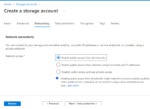
Step 4: Wait for a while for deployment is in progress. Once it completes will go to the Azure Stream Analytic.

Step 6: Search the Stream analytics jobs.

Step 7: Click on Create to establish the stream jobs

Step 8: Enter the project details for fully managed SQL-based stream processing.
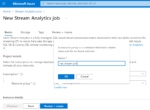
Step 9: Enter the configuration for the new stream analytics job, region and make sure for the Streaming units.
Here we kept 3 streaming units.
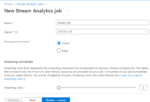
Step 10: Now go to the Review + Create we will review all the configurations. After that click on the Create button.
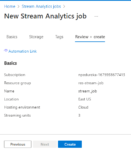
Step 11: Once the deployment is completed, Click on Go to resources.

Step 12: Once the Stream Job is created, overview the configuration of the pipeline.

Step 13: At the left-hand navigation panel under the job topology, click on Inputs.
Now Click on the add input and select the streaming input as Event Hub.
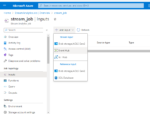
Step 14: Fill in all details for the input as shown in the screenshot below.

Step 15: We can see the pipeline for the input event hub is created.

Step 16: Similarly, at the left-hand navigation panel under the job topology, click on Outputs.
Now Click on the add Output and select the streaming Output as Blob storage.
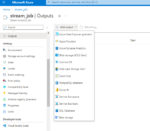
Step 17: In the Blob storagewindow, type or select the following values in the pane, and in the Dropdown fill the following values Min row = 10 and Max time = 5, and finally, clickSave. You can close the output screen to return to the Resource Group page.
Step 18: In the Start-Job dialog box that opens, click on Now, and then click Start.
You can validate the streaming data by going to the resource group that was created in the initial steps and selecting the storage container created.
So these are the steps that can be followed to create an Azure Stream Analytics job using the Azure portal, specify job input and output.
Transform your career landscape with Azure Solution Architect Certification!
Azure Stream Analytics is a fully managed, real-time analytics service that can be used to process and analyze streaming data from a variety of sources, including applications, devices, sensors, clickstreams, and social media feeds. It can be used to build a variety of real-time analytics solutions for streaming OTT platforms, including:
It can be used to track user engagement and behaviour in real time. This data can be used to identify trends, patterns, and anomalies in user behaviour. This information can then be used to improve the user experience, personalize content, and prevent fraud.
It can be used to recommend content to users in real time. This can be done by analyzing user behavior data to identify patterns and preferences. This information can then be used to recommend content that is likely to be of interest to the user.
Azure Stream Analytics can be used to insert ads into streaming content in real time. This can be done by analyzing user behaviour data to identify optimal ad insertion points. This information can then be used to maximize ad revenue.
Here are some case studies and implementation examples of Azure Stream Analytics for streaming OTT platforms:


Azure Stream Analytics offers a powerful and efficient real-time solution for processing and analyzing streaming data. With its serverless architecture and scalability, it provides a hassle-free experience for developers and data analysts. By leveraging various input and output sources, you can seamlessly integrate your data pipeline and gain valuable insights from your streaming data.
In various industries, It has demonstrated its versatility and effectiveness. It has been used for real-time monitoring and predictive maintenance in manufacturing, quality control and anomaly detection in production lines, and supply chain optimization and inventory management. These applications highlight the ability of Stream Analytics to drive operational efficiency, enhance decision-making, and improve overall business performance.
Moreover, in the context of streaming OTT platforms, Azure Stream Analytics plays a crucial role in delivering personalized experiences to users. It enables real-time analytics for user engagement and behaviour, content recommendation and personalization, as well as ad insertion and monetization strategies. Leading streaming platforms like Netflix, Amazon Prime Video, and YouTube have leveraged Azure Stream Analytics to enhance their services and provide seamless user experiences.
If you’re interested in pursuing a career as an Azure Data Engineer, consider taking an Azure Data Engineer Associate Certification Course with a reputable provider such as Edureka. With Edureka, you can learn from industry experts and gain hands-on experience working with real-world projects. Invest in your career and become an Azure Data Engineer today with Edureka.
 Thank you for registering Join Edureka Meetup community for 100+ Free Webinars each month JOIN MEETUP GROUP
Thank you for registering Join Edureka Meetup community for 100+ Free Webinars each month JOIN MEETUP GROUPedureka.co